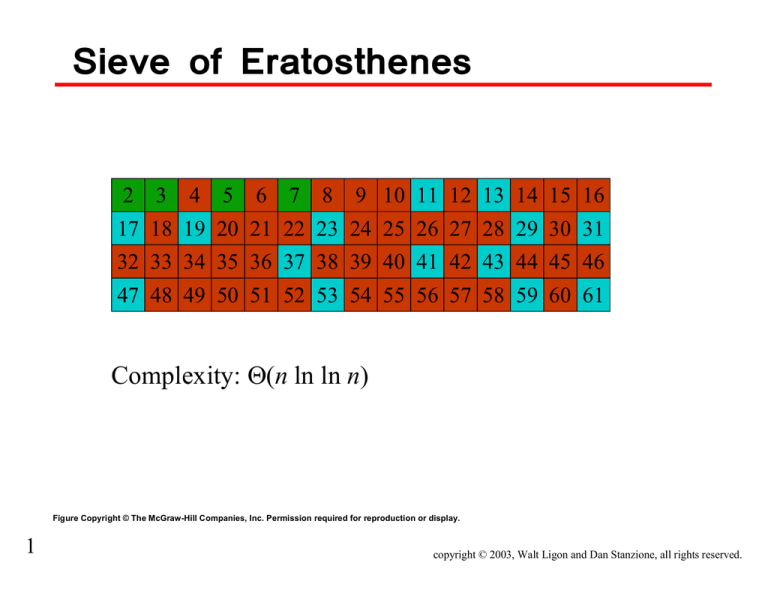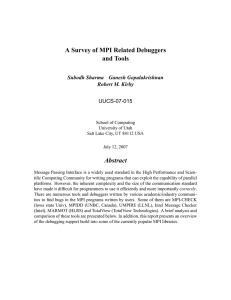
Sieve of Eratosthenes
2
3
4
5
6 7
8
9 10 11 12 13 14 15 16
17 18 19 20 21 22 23 24 25 26 27 28 29 30 31
32 33 34 35 36 37 38 39 40 41 42 43 44 45 46
47 48 49 50 51 52 53 54 55 56 57 58 59 60 61
Complexity: Θ(n ln ln n)
Figure Copyright © The McGraw-Hill Companies, Inc. Permission required for reproduction or display.
1
copyright © 2003, Walt Ligon and Dan Stanzione, all rights reserved.
Pseudo-code
1. Create list of unmarked natural numbers 2, 3, …, n
2. k ← 2
3. Repeat
(a) Mark all multiples of k between k2 and n
(b) k ← smallest unmarked number > k
until k2 > n
4. The unmarked numbers are primes
Figure Copyright © The McGraw-Hill Companies, Inc. Permission required for reproduction or display.
2
copyright © 2003, Walt Ligon and Dan Stanzione, all rights reserved.
Parallelizing the Algorithm
3.a Mark all multiples of k between k2 and n
⇒
for all j where k2 ≤ j ≤ n do
if j mod k = 0 then
mark j (it is not a prime)
endif
endfor
3.b Find smallest unmarked number > k
⇒
Min-reduction (to find smallest unmarked number > k)
Broadcast (to get result to all tasks)
Figure Copyright © The McGraw-Hill Companies, Inc. Permission required for reproduction or display.
3
copyright © 2003, Walt Ligon and Dan Stanzione, all rights reserved.
Block Decomposition Method #1
Let r = n mod p
If r = 0, all blocks have same size
Else
First r blocks have size n/p
Remaining p-r blocks have size
n/p
17 elements divided among 7 processes
17 elements divided among 5 processes
17 elements divided among 3 processes
Figure Copyright © The McGraw-Hill Companies, Inc. Permission required for reproduction or display.
4
copyright © 2003, Walt Ligon and Dan Stanzione, all rights reserved.
Block Decomposition Method #2
Scatters larger blocks among processes
First element controlled by process i
in p
i 1 n p 1
Last element controlled by process i
p j 1
Process controlling element j
1 n
17 elements divided among 7 processes
17 elements divided among 5 processes
17 elements divided among 3 processes
5
Figure Copyright © The McGraw-Hill Companies, Inc. Permission required for reproduction or display.
copyright © 2003, Walt Ligon and Dan Stanzione, all rights reserved.
Comparing Block Decompositions
Our choice
Operation
Method 1
Method 2
Low index
4
2
High index
6
4
Owner
7
4
Assuming no operations for “floor” function
Figure Copyright © The McGraw-Hill Companies, Inc. Permission required for reproduction or display.
6
copyright © 2003, Walt Ligon and Dan Stanzione, all rights reserved.
Block Decomposition Macros
#define BLOCK_LOW(id,p,n)
((i)*(n)/(p))
#define BLOCK_HIGH(id,p,n) \
(BLOCK_LOW((id)+1,p,n)-1)
#define BLOCK_SIZE(id,p,n) \
(BLOCK_LOW((id)+1)-BLOCK_LOW(id))
#define BLOCK_OWNER(index,p,n) \
(((p)*(index)+1)-1)/(n))
Figure Copyright © The McGraw-Hill Companies, Inc. Permission required for reproduction or display.
7
copyright © 2003, Walt Ligon and Dan Stanzione, all rights reserved.
Local and Global Indicies
L 0 1
L 0 1 2
G 0 1
G 2 3 4
L 0 1
G 5 6
L 0 1 2
L 0 1 2
G 7 8 9
G 10 11 12
Figure Copyright © The McGraw-Hill Companies, Inc. Permission required for reproduction or display.
8
copyright © 2003, Walt Ligon and Dan Stanzione, all rights reserved.
Looping with Local/Global Index
Sequential program
for (i = 0; i < n; i++) {
…
Index i on this process…
}
Parallel program
size = BLOCK_SIZE (id,p,n);
for (i = 0; i < size; i++) {
gi = i + BLOCK_LOW(id,p,n);
}
…takes place of sequential program’s index gi
Figure Copyright © The McGraw-Hill Companies, Inc. Permission required for reproduction or display.
9
copyright © 2003, Walt Ligon and Dan Stanzione, all rights reserved.
Parallel Algorithm
1. Create list of unmarked natural numbers 2, 3, …, n
Each process creates its share of list
Each process does this
Each process marks its share of list
3. Repeat
2. k = 2
(a) Mark all multiples of k between k2 and n
(b) k = smallest unmarked number > k
Process 0 only
(c) Process 0 broadcasts k to rest of processes
until k2 > m
4. The unmarked numbers are primes
n lnln n p
10
5. Reduction to determine number of primes
n ln n
log p
Figure Copyright © The McGraw-Hill Companies, Inc. Permission required for reproduction or display.
copyright © 2003, Walt Ligon and Dan Stanzione, all rights reserved.
Task/Channel Graph
Figure Copyright © The McGraw-Hill Companies, Inc. Permission required for reproduction or display.
11
copyright © 2003, Walt Ligon and Dan Stanzione, all rights reserved.
Code (part 1)
#include <mpi.h>
#include <math.h>
#include <stdio.h>
#include "MyMPI.h"
#define MIN(a,b) ((a)<(b)?(a):(b))
int main (int argc, char *argv[])
{
...
MPI_Init (&argc, &argv);
MPI_Barrier(MPI_COMM_WORLD);
elapsed_time = -MPI_Wtime();
MPI_Comm_rank (MPI_COMM_WORLD, &id);
MPI_Comm_size (MPI_COMM_WORLD, &p);
if (argc != 2) {
if (!id) printf ("Command line: %s <m>\n", argv[0]);
MPI_Finalize(); exit (1);
}
Figure Copyright © The McGraw-Hill Companies, Inc. Permission required for reproduction or display.
12
copyright © 2003, Walt Ligon and Dan Stanzione, all rights reserved.
Code (part 2)
n = atoi(argv[1]);
low_value = 2 + BLOCK_LOW(id,p,n-1);
high_value = 2 + BLOCK_HIGH(id,p,n-1);
size = BLOCK_SIZE(id,p,n-1);
proc0_size = (n-1)/p;
if ((2 + proc0_size) < (int) sqrt((double) n)) {
if (!id) printf ("Too many processes\n");
MPI_Finalize();
exit (1);
}
marked = (char *) malloc (size);
if (marked == NULL) {
printf ("Cannot allocate enough memory\n");
MPI_Finalize();
exit (1);
}
Figure Copyright © The McGraw-Hill Companies, Inc. Permission required for reproduction or display.
13
copyright © 2003, Walt Ligon and Dan Stanzione, all rights reserved.
Code (part 4)
for (i = 0; i < size; i++) marked[i] = 0;
if (!id) index = 0;
prime = 2;
do {
if (prime * prime > low_value)
first = prime * prime - low_value;
else {
if (!(low_value % prime)) first = 0;
else first = prime - (low_value % prime);
}
for (i = first; i < size; i += prime) marked[i] = 1;
if (!id) {
while (marked[++index]);
prime = index + 2;
}
MPI_Bcast (&prime, 1, MPI_INT, 0, MPI_COMM_WORLD);
} while (prime * prime <= n);
Figure Copyright © The McGraw-Hill Companies, Inc. Permission required for reproduction or display.
14
copyright © 2003, Walt Ligon and Dan Stanzione, all rights reserved.
Code (part 4)
count = 0;
for (i = 0; i < size; i++)
if (!marked[i]) count++;
MPI_Reduce (&count, &global_count, 1, MPI_INT, MPI_SUM,
0, MPI_COMM_WORLD);
elapsed_time += MPI_Wtime();
if (!id) {
printf ("%d primes are less than or equal to %d\n",
global_count, n);
printf ("Total elapsed time: %10.6f\n", elapsed_time);
}
MPI_Finalize ();
return 0;
}
Figure Copyright © The McGraw-Hill Companies, Inc. Permission required for reproduction or display.
15
copyright © 2003, Walt Ligon and Dan Stanzione, all rights reserved.
Delete even integers
Replicating computation of primes to √n
Eliminates broadcast step
Reorganize loops
Cuts number of computations in half
Frees storage for larger values of n
Each process finds own sieving primes
Optimizations
Increases cache hit rate
Figure Copyright © The McGraw-Hill Companies, Inc. Permission required for reproduction or display.
16
copyright © 2003, Walt Ligon and Dan Stanzione, all rights reserved.
Loop Reorganization
Figure Copyright © The McGraw-Hill Companies, Inc. Permission required for reproduction or display.
17
copyright © 2003, Walt Ligon and Dan Stanzione, all rights reserved.
User Defined Datatypes
Methods for creating data types
MPI_Type_contiguous();
MPI_Type_vector();
MPI_Type_indexed();
MPI_Type_struct();
MPI_Pack();
MPI_Unpack();
18
MPI datatypes defined similar to modern
programming languages (C,C++,F90)
Allows communication and I/O operations to
use the same datatypes as rest of program
Makes expressing the partitioning of
datasets easier
copyright © 2003, Walt Ligon and Dan Stanzione, all rights reserved.
Every MPI datatype has a few
characteristics
Some datatype terminology
type signature
type map
%
$
#
"
!
list of the basic datatypes (in order) that make
up the derived type
basic dataypes
lower bound of each type
extent of the type (size + buffering)
Some of this information is available about
MPI datatypes through:
MPI_Get_extent
MPI_Get_size
19
copyright © 2003, Walt Ligon and Dan Stanzione, all rights reserved.
&
Contiguous Array
Creates an array of counts elements:
MPI_Type_contiguous(int count,
MPI_Datatype oldtype,
MPI_Datatype *newtype)
20
copyright © 2003, Walt Ligon and Dan Stanzione, all rights reserved.
'
Strided Vector
Constructs a cyclic set of elements
)
(
MPI_Type_vector(int count,
int blocklength,
int stride,
MPI_Datatype oldtype,
MPI_Datatype *newtype);
Stride specified in number of elements
Stride can be specified in bytes
*
MPI_Type_hvector();
21
Stride counts from start of block
copyright © 2003, Walt Ligon and Dan Stanzione, all rights reserved.
+
Indexed Vector
Allows an irregular pattern of elements
Displacements specified in number of
elements
-
,
MPI_Type_indexed(int count,
int *array_of_blocklengths,
int *array_of_displacements,
MPI_Datatype oldtype,
MPI_Datatype *newtype);
Displacements can be specified in bytes
.
MPI_Type_hindexed();
A shortcut if all blocks are the same
length:
MPI_Type_create_indexed_block()
22
copyright © 2003, Walt Ligon and Dan Stanzione, all rights reserved.
/
Structured Records
Allows different types to be combined
1
0
MPI_Type_struct(int count,
int *array_of_blocklengths,
MPI_Aint *array_of_displacements,
MPI_Datatype *array_of_types,
MPI_Datatype *newtype);
23
Blocklengths specified in number of
elements
Displacements specified in bytes
copyright © 2003, Walt Ligon and Dan Stanzione, all rights reserved.
2
Committing types
In order for a user-defined derived datatype
to be used as an argument to other MPI
calls, the type must be “committed”.
4
3
MPI_Type_commit(type);
MPI_Type_free(type);
24
Use commit after calling the type
constructor, but before using the type
anywhere else
Call free after the type is no longer in use
(no one actually does this, but it makes
computer scientists happy...)
copyright © 2003, Walt Ligon and Dan Stanzione, all rights reserved.
5
Pack and Unpack
Packs sparse structures into contiguous
memory
MPI_Pack(void* inbuf, int incount,
MPI_Datatype datatype,
void *outbuf, int outsize,
int *position, MPI_Comm comm);
MPI_Unpack(void* inbuf, int insize,
int *position, void *outbuf,
int outcount,
MPI_Datatype datatype,
MPI_Comm comm);
25
copyright © 2003, Walt Ligon and Dan Stanzione, all rights reserved.
8
7
6
Dealing with Groups
A group is a set of tasks
Groups are used to construct
communicators
Group accessors:
int MPI_Group_size(MPI_Group group, int
*size)
int MPI_Group_rank(MPI_Group group, int
*rank)
int MPI_Group_translate_ranks (MPI_Group
group1, int n, int *ranks1, MPI_Group
group2, int *ranks2)
int MPI_Group_compare(MPI_Group
group1,MPI_Group group2, int *result)
26
copyright © 2003, Walt Ligon and Dan Stanzione, all rights reserved.
9
Creating Groups
Group constructors:
int MPI_Comm_group(MPI_Comm comm, MPI_Group *group)
int MPI_Group_union(MPI_Group group1, MPI_Group
group2, MPI_Group *newgroup)
int MPI_Group_intersection(MPI_Group group1,
MPI_Group group2, MPI_Group *newgroup)
int MPI_Group_difference(MPI_Group group1, MPI_Group
group2, MPI_Group *newgroup)
int MPI_Group_incl(MPI_Group group, int n, int
*ranks, MPI_Group *newgroup)
int MPI_Group_excl(MPI_Group group, int n, int
*ranks, MPI_Group *newgroup)
int MPI_Group_range_incl(MPI_Group group, int n, int
ranges[][3], MPI_Group *newgroup)
int MPI_Group_range_excl(MPI_Group group, int n, int
ranges[][3], MPI_Group *newgroup)
27
copyright © 2003, Walt Ligon and Dan Stanzione, all rights reserved.
:
Destroying Groups
Group destructors:
int MPI_Group_free(MPI_Group *group)
28
copyright © 2003, Walt Ligon and Dan Stanzione, all rights reserved.
>
=
<
;
Dealing with Communicators
MPI collective operations deal with all the processes in a
communicator
MPI_COMM_WORLD by default contains every task in
your MPI job
Other communicators can be defined to allow collective
operations on a subset of the tasks
Communicator Accessors:
A
@
?
int MPI_Comm_size(MPI_Comm comm, int *size)
Returns the size of the group in comm
int MPI_Comm_rank(MPI_Comm comm, int *rank)
Returns the rank of the caller in that communicator
int MPI_Comm_compare(MPI_Comm comm1, MPI_Comm
comm2, int *result)
Returns if two communicators are the same, similar(same
tasks but different ranks), or different
29
copyright © 2003, Walt Ligon and Dan Stanzione, all rights reserved.
Creating Communicators
B
int MPI_Comm_dup(MPI_Comm comm, MPI_Comm
*newcomm)
Creates an exact copy of the communicator
D
C
int MPI_Comm_create(MPI_Comm comm, MPI_Group
group, MPI_Comm *newcomm)
Creates a new communicator with the contents of group
Group must be a subset of Comm
E
int MPI_Comm_split(MPI_Comm comm, int color,
int key,MPI_Comm *newcomm)
Creates a communicator for each distinct value of color,
ranked by key
30
copyright © 2003, Walt Ligon and Dan Stanzione, all rights reserved.
Destroying Communicators
F
int MPI_Comm_free(MPI_Comm comm)
Destroys the named communicator
31
copyright © 2003, Walt Ligon and Dan Stanzione, all rights reserved.
MPI allows processes to be grouped in
logical topologies
Topologies can aid the programmer
N
32
Convenient naming methods for processes in a
group
Naming can match communication patterns
a standard mechanism for representing
common algorithmic concepts (i.e. 2D grids)
Topologies can aid the runtime environment
M
L
K
J
I
H
G
Topologies and Communicators
Better mappings of MPI tasks to hardware
nodes
Not really useful in a simple cluster
environment....
copyright © 2003, Walt Ligon and Dan Stanzione, all rights reserved.
Cartesian Topologies
T
S
R
Q
P
O
int MPI_Cart_create(MPI_Comm comm_old, int ndims,
int *dims, int *periods, int reorder, MPI_Comm
*comm_cart)
33
comm_old - input communicator
ndims - # of dimensions in cartesian grid
dims - integer array of size ndims specifying the
number of processes in each dimension
periods - true/false specifying whether each
dimension is periodic (wraps around)
reorder - ranks may be reordered or not
comm_cart - new communicator containing new
topology.
copyright © 2003, Walt Ligon and Dan Stanzione, all rights reserved.
U
MPI_DIMS_CREATE
A helper function for specifying a likely
dimension decomposition.
Y
X
W
V
int MPI_Dims_create(int nnodes, int
ndims, int *dims)
nnodes - total nodes in grid
ndims - number of dimensions
dims - array returned with dimensions
Example:
Z
MPI_Dims_create(6,2,dims
will return (3,2) in dims
\
[
MPI_Dims_create(6,3,dims)
34
will return (3,2,1) in dims
No rounding or ceiling function provided
copyright © 2003, Walt Ligon and Dan Stanzione, all rights reserved.
]
Cartesian Inquiry Functions
MPI_Cartdim_get will return the number
of dimensions in a Cartesian structure
MPI_Cart_get provides information on an
existing topology
_
^
int MPI_Cartdim_get(MPI_Comm comm, int
*ndims);
Arguments roughly mirror the create call
`
int MPI_Cart_get(MPI_Comm comm,int maxdims,
int *dims, int *periods, int *coords);
35
Maxdims keeps a given communicator from
overflowing your arguments
copyright © 2003, Walt Ligon and Dan Stanzione, all rights reserved.
Task IDs in a Cartesian coordinate system
correspond to ranks in a "normal"
communicator.
b
a
Cartesian Translator Functions
point-to-point communication routines
(send/receive) rely on ranks
d
c
int MPI_Cart_rank(MPI_Comm comm, int
*coords, int *rank)
int MPI_Cart_coords(MPI_Comm comm, int
rank, int maxdims, int *coords)
36
Coords - cartesian coordinates
rank - ranks
copyright © 2003, Walt Ligon and Dan Stanzione, all rights reserved.
Cartesian Shift function
direction - coordinate dimension of shift
disp - displacement (can be positive or
negative)
rank_source and rank_dest are return
values
h
g
f
e
int MPI_Cart_Shift(MPI_Comm comm, int
direction, int disp, int *rank_source, int
*rank_dest)
37
Use that source and dest to call MPI_Sendrecv
copyright © 2003, Walt Ligon and Dan Stanzione, all rights reserved.
Cartesian Shift Example
MPI_Comm ICOMM;
MPI_Status status;
int NY, srank, rrank;
int idims[2] = {4, 4};
int periods[2] = {1, 1};
void *plane1, *plane2;
MPI_Cart_create(MPI_COMM_WORLD, 2, idims, periods,
0, &ICOMM);
MPI_Cart_shift(ICOMM, 0, 1, &rrank, &srank);
MPI_Sendrecv(plane1, NY, MPI_DOUBLE, srank,
plane2, NY, MPI_DOUBLE, rrank,
ICOMM, &status);
MPI_Cart_shift(ICOMM, 1, -1, &rrank, &srank);
MPI_Sendrecv(plane1, NY, MPI_DOUBLE, srank,
plane2, NY, MPI_DOUBLE, rrank,
ICOMM, &status);
38
copyright © 2003, Walt Ligon and Dan Stanzione, all rights reserved.
Graph Topologies
l
k
j
i
int MPI_Graph_create(MPI_Comm comm_old, int
nnodes, int *index, int *edges, int reorder,
MPI_Comm *comm_graph)
nnodes - number of nodes
index - the number of edges adjacent to all
nodes 0 .. i
edges - adjacent nodes for each node
reorder - allow node ranks to be reordered
Thus, in C, index[0] is the degree of node zero, and index[i] index[i-1] is the degree of node i, i=1, ..., nnodes-1; the list of
neighbors of node zero is stored in edges[j], for 0 <= j <=
index[0]-1 and the list of neighbors of node i, i>0, is stored in
edges[j], index[i-1]+1 <= j <= index[i]-1.
39
copyright © 2003, Walt Ligon and Dan Stanzione, all rights reserved.
Graph Example
0
1
2
3
4
5
6
node
0
1
2
3
4
5
6
adjacent nodes
1, 4
0, 2, 3
1
1
0, 5, 6
4
4
MPI_Comm newcomm;
int nnodes = 7;
int index[] = {2, 5, 6, 7, 10, 11, 12};
int edges[] = {1, 4, 0, 2, 3, 1, 1, 0, 5, 6, 4, 4};
MPI_Graph_create(MPI_COMM_WORLD, nnodes, index,
edges, 0, &newcomm);
40
copyright © 2003, Walt Ligon and Dan Stanzione, all rights reserved.
Graph Inquiry Functions
m
int MPI_Graphdims_get(MPI_Comm comm, int
*nnodes, int *nedges)
Provides info needed to size index and edges
n
int MPI_Graph_get(MPI_Comm comm, int maxindex,
int maxedges, int *index, int *edges)
Get index and edges
o
int MPI_Graph_neighbors_count(MPI_Comm comm,
int rank, int *nneighbors)
Get number of neighbors
p
int MPI_Graph_neighbors(MPI_Comm comm, int
rank, int maxneighbors, int *neighbors)
Get neighbors
41
copyright © 2003, Walt Ligon and Dan Stanzione, all rights reserved.


